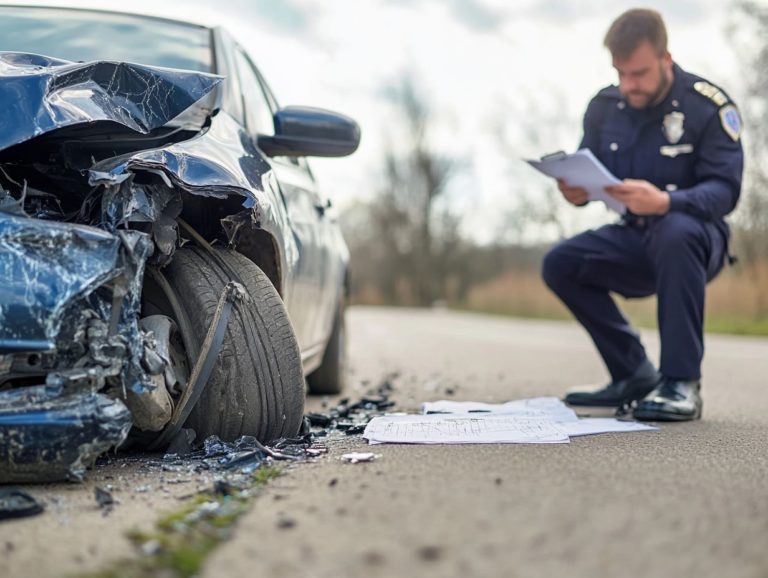What is a Vehicle Identification Number (VIN)?
A Vehicle Identification Number (VIN) is not just a random assortment of letters and numbers; it serves as a unique identifier that encapsulates the story of your vehicle s history and specifications.
This article delves into what VINs are and why they matter, tracing their evolution through the years while breaking down the meaning behind each digit and letter. You ll find a detailed, step-by-step guide on reading and decoding a VIN, as well as a discussion on the various ways this essential tool is used in vehicle identification and tracking.
Explore the captivating world of VINs and uncover their significance in the realm of automotive history.
Contents
Key Takeaways:

- A VIN is a unique 17-digit code assigned to a vehicle for identification and tracking purposes.
- The use of VINs was standardized in the 1980s and has evolved to include more information about a vehicle’s history.
- Understanding the meaning of each digit and letter in a VIN can provide valuable information about a vehicle’s make, model, and history.
Understanding VINs
The Vehicle Identification Number, or VIN, is a special combination of letters and numbers assigned to every vehicle in the car industry. This code holds essential information about your car, such as its manufacturer, model, specifications, and production history.
Grasping the significance of VINs is crucial not just for car enthusiasts but also for professionals in insurance and registration. It serves as a key component in vehicle identification and tracking, ensuring that all vehicle details are carefully recorded for different uses.
Learning about VINs can really boost your understanding of cars!
Definition and Purpose
The VIN serves as a unique identifier for your vehicle, fulfilling multiple roles that include tracking its history and ensuring you have the right insurance coverage.
This 17-character alphanumeric code acts as a fingerprint for your automobile, helping with various vital functions. For instance, it gives you the power to conduct thorough background checks on a vehicle s past, revealing details like accidents and previous ownership. This information is crucial for smart buying decisions!
Insurance companies also leverage the VIN to calculate accurate premiums based on your vehicle’s specifications and history. Law enforcement also uses this identifier to combat theft and recover stolen vehicles, highlighting its significance far beyond a mere reference number.
History of VINs
The history of Vehicle Identification Numbers (VINs) traces back to the late 1950s, when manufacturers and regulatory authorities recognized the necessity for a standardized vehicle identification system. This initiative sought to establish a unique identifier for each vehicle, streamlining the processes of tracking, ownership records, and safety compliance, ultimately shaping the modern vehicle registration landscape.
Over the decades, VINs have undergone significant evolution, influenced by various regulations and standards, leading to the robust systems you now rely on for insurance, law enforcement, and comprehensive vehicle history reports.
VIN Evolution and Standardization

VINs have transformed how we identify vehicles! Their evolution and standardization have ensured that every vehicle carries a unique identifier, making registration and tracking easy.
Manufacturers began assigning Vehicle Identification Numbers (VINs) in the 1950s. However, it wasn t until the 1980s that major regulatory bodies recognized the need for a standardized system. In 1981, the National Highway Traffic Safety Administration (NHTSA) introduced the VIN system, paving the way for uniformity among manufacturers. Key developments, like the establishment of the World Manufacturer Identifier (WMI) in 1983 and the adoption of a 17-character format in 1989, solidified this consistency.
This standardization impacts every vehicle owner. It enhances the accuracy of vehicle histories, simplifies insurance assessments, and facilitates recalls, ultimately safeguarding consumers and improving safety on the roads.
Components of a VIN
A Vehicle Identification Number (VIN) consists of 17 characters, each serving a distinct purpose and offering insights into the vehicle, its manufacturer, and its specifications. Each character encodes essential details, including the manufacturer s identity, vehicle type, model year, production location, and a unique serial number.
Understanding VIN components is vital for identifying and tracking a vehicle’s history, which impacts registration, insurance, and resale value.
Meaning of Each Digit and Letter
Every digit and letter in a VIN creates a profile of the vehicle’s attributes.
The first character identifies the country of manufacture; for example, ‘1’ means the vehicle is from the United States, while ‘J’ indicates Japan. The second position reveals the manufacturer, with ‘G’ signifying General Motors. The third character completes the WMI, pinpointing the division responsible for production.
Characters four through eight detail the vehicle’s brand, engine size, type, and model. The ninth digit serves as a security check, while the tenth character denotes the model year if you see ‘K,’ it s tied to 2019. The eleventh digit points to the assembly plant, and the remaining digits reveal the vehicle’s unique serial number.
How to Read and Decode a VIN
Reading and decoding a VIN might seem overwhelming at first, but a systematic approach makes it easy to uncover essential vehicle details.
By mastering this unique alphanumeric code, you can verify crucial information such as the manufacturer, model, and production year. You can also track the vehicle’s accident history and ownership records.
This insight is valuable for anyone buying a used car or ensuring that you have the right insurance coverage.
Step-by-Step Guide

This step-by-step guide empowers you to decode a VIN with ease, unlocking valuable insights into a vehicle’s history and specifications.
By understanding each segment of the VIN, you can reveal essential information like the manufacturer, model year, engine type, and production details. The first three digits typically indicate the World Manufacturer Identifier (WMI), while the fourth to eighth characters provide details on the vehicle’s attributes, including body style and transmission type.
Grasping these components is crucial for accessing accurate vehicle history reports. This knowledge ensures that any potential purchase is informed by a comprehensive view of past incidents, recalls, or modifications, guiding you in making smart buying decisions.
Ready to decode your VIN? Let s get started!
Uses of Vehicle Identification Numbers (VINs)
Discover how Vehicle Identification Numbers (VINs) are your key to unlocking the mysteries of vehicle history! The uses of VINs go well beyond simple identification; they are essential in numerous facets of vehicle management. From tracking history to facilitating insurance claims and ensuring compliance with regulations, VINs are invaluable.
By harnessing the unique information embedded in a VIN, stakeholders like insurers, dealerships, and law enforcement can effectively monitor vehicles throughout their entire lifecycle. Recognizing the significance of VINs enhances the transparency and reliability of vehicle transactions and provides peace of mind for both buyers and sellers alike.
Vehicle Identification and Tracking
Vehicle identification and tracking hinge on the VIN, allowing you and other stakeholders to access precise data regarding a car’s history, ownership, and specifications.
This unique 17-character code is essential across various sectors. It enables everything from insurance assessments to dealership operations and law enforcement initiatives. For instance, insurance companies rely on VINs to evaluate risk and set premiums based on a vehicle s attributes and past claims, ensuring you receive fair pricing.
Dealerships also make good use of the VIN to monitor inventory and assess the market value of models, empowering you to make informed decisions as a potential buyer. Law enforcement agencies also find the VIN to be an invaluable resource in recovering stolen vehicles, contributing to the safety and security of everyone on the roads.
Vehicle History Reports
A vehicle history report, generated using the VIN, offers you essential insights into a car’s past, including accident history, title changes, and ownership records.
These reports are crucial in the car-buying process, empowering you to make informed decisions before finalizing any purchase. By outlining previous incidents and registrations, they help you identify any past issues that could impact the vehicle’s reliability and safety. Understanding this background aids in negotiating a fair price and reveals whether the vehicle has been well-maintained.
Insurance companies often rely on details from these reports to determine coverage rates, making them essential for both buyers and sellers in ensuring a transparent transaction.
Frequently Asked Questions

What is a Vehicle Identification Number (VIN)?
A Vehicle Identification Number (VIN) is a unique 17-digit code assigned to every vehicle by the manufacturer. It serves as a unique identifier and contains important information about the car’s make, model, and production details.
Why is a VIN important?
A VIN is vital because it allows for accurate identification of a vehicle. It is used by insurance companies, law enforcement, and government agencies to verify a vehicle’s ownership and history.
Where can I find my VIN?
Your VIN is typically found on the driver’s side dashboard near the windshield, on the driver’s side door jamb, or on important documents such as the vehicle title and registration.
Are VINs the same for all vehicles?
No, each vehicle has a unique VIN. Even if two cars are the same make and model, their VINs will still be different.
Can I decode a VIN to find out information about a vehicle?
Yes, VIN decoding is a way to read the information coded in a VIN, such as the manufacturer, model, and production details. There are many online VIN decoding tools available.
What should I do if I suspect a VIN has been altered or tampered with?
If you suspect that a VIN has been altered or tampered with, contact the police and your local Department of Motor Vehicles. Altered VINs can indicate a stolen vehicle or fraudulent activity.






